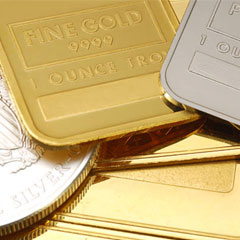Tax Implications of Holding Precious Metal Assets in Your IRA
January 4, 2021 | IRS Regulation, Tax Planning
 With the stock market hitting record levels and interest rates at historic lows, some investors are moving away from low-risk securities like bonds and money-market funds and investing in precious metal such as gold, silver or platinum. If you’re considering doing the same within your IRA, you should consider some of these tax related issues.
With the stock market hitting record levels and interest rates at historic lows, some investors are moving away from low-risk securities like bonds and money-market funds and investing in precious metal such as gold, silver or platinum. If you’re considering doing the same within your IRA, you should consider some of these tax related issues.
Precious Metal Assets Held in Your IRA
An IRA investment in any metal or coin generally counts as an acquisition of a collectible item. This means the transaction is a taxable distribution from the IRA followed by a purchase of the metal or coin by the IRA owner (you). This rule pretty much prohibits IRAs from investing in precious metals — but there is an exception.
Tax Code allows IRAs to invest in certain gold, silver and platinum coins, as well as gold, silver, platinum and palladium bullion that meets certain purity standards. The coins or bullion must be held by the IRA trustee or custodian rather than by the IRA owner. These rules apply equally to traditional IRAs, Roth IRAs, SEP accounts and SIMPLE-IRAs.
IRA Investments in Precious Metals
Under this exception, IRAs can own these precious metals:
- American Gold Eagle coins
- Canadian Gold Maple Leaf coins
- American Silver Eagle coins
- American Platinum Eagle coins
- Gold, silver, platinum and palladium bars (bullion) that meet applicable purity standards.
However, finding a trustee to set up a self-directed IRA and facilitate the physical transfer and storage of precious metal assets can be challenging. There aren’t many outfits that handle these types of investments. The ones that do often have set up fees, administrative fees and an annual fee to store and insure the physical precious metals. Additional fees may be charged for transactions including contributions, distributions and commissions for precious metal purchases and sales.
Indirect IRA Investments via Precious Metal ETFs
There is a more practical alternative to dealing with the administrative issues related to the physical ownership of precious metals. You can buy shares of an exchange traded fund (ETF) that tracks the value of a precious metal.
Unlike the physical ownership of precious metals, which the IRS treats as an acquisition of a collectible, IRAs can buy shares in precious metal ETFs that are classified as grantor investment trusts without any such problems.
Another indirect (and simple) way to invest in precious metals is to have your IRA buy common stock shares of mining companies or mutual funds that hold mining stocks.
Age-Related Considerations for IRA Owners
Using an IRA to invest in precious metal assets can pose additional challenges as you near or reach retirement. Once an IRA owner reaches age 72, required minimum distributions (RMDs) must be taken (Note: The CARES Act suspended RMDs for 2020). Because precious metals don’t have the liquidity of some other investments such as stocks or mutual funds, it can take extra effort to allow for RMDs.
That said, you aren’t required to take RMDs from each IRA. The only requirement is that the proper total amount (at least) be withdrawn from one or more accounts. So, you could have one IRA invested in precious metals, and another IRA invested in more liquid assets from which you take your annual RMD.
Should Your IRA Invest in Precious Metals?
IRAs can invest in gold and other precious metals, but doing so is often more complicated than other types of investments. As always, you should know the risks and tax issues associated with this type of investment.
